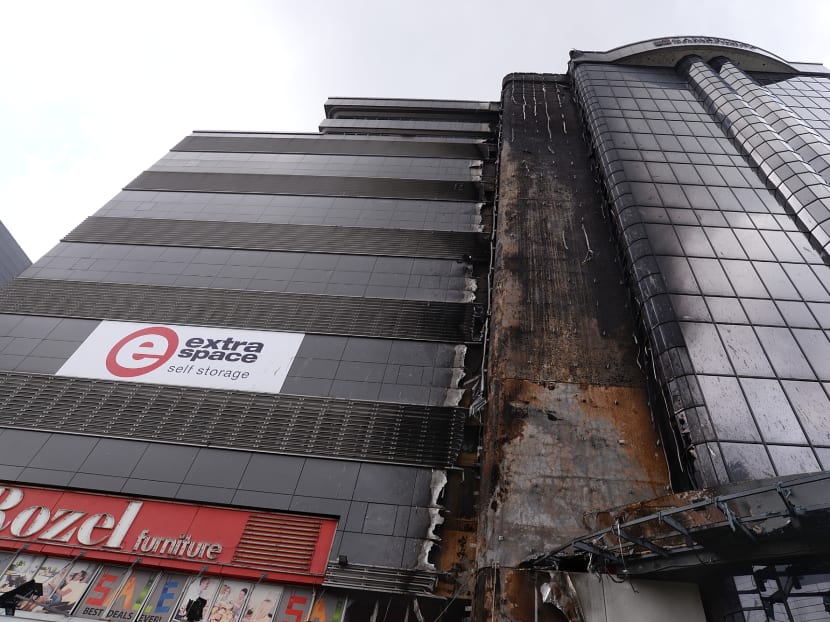Stricter safety regulations for building cladding: SCDF
SINGAPORE — The Singapore Civil Defence Force (SCDF) is planning to tighten safety regulations and certification processes for building cladding, after composite panels in more than 40 buildings were found to have failed fire safety requirements last year.

Aftermath of the warehouse fire at 30 Toh Guan Road on May 4, 2017. The authorities will adopt the recommendations put forward by an advisory panel to improve fire safety, including reviewing the regulatory regime for cladding.
SINGAPORE — The Singapore Civil Defence Force (SCDF) is planning to tighten safety regulations and certification processes for building cladding, after composite panels in more than 40 buildings were found to have failed fire safety requirements last year.
On Thursday (Nov 8), Home Affairs and Law Minister K Shanmugam said that the authorities will adopt the proposed recommendations put forward by an advisory panel — formed earlier this year — to improve fire safety. They include the testing of cladding samples from every new project site.
The recommendations are mainly focused on composite panels, which make up cladding. The building cladding is an extra layer that covers the exterior walls of buildings, and used mostly for protective or decorative purposes.
The Ministry of Home Affairs and the SCDF are now reviewing the Fire Safety Act with the intention to amend it. This could result in suppliers of non-compliant fire safety products being held legally accountable for their actions.
“We will put (the recommendations) through legislation by the first half of next year,” Mr Shanmugam said.
Most of the recommendations are set to be implemented about six months after amendments to the Act come into force, so the industry can have time to adjust to the new requirements.
WHAT STARTED THIS?
In May last year, an industrial building at 30 Toh Guan Road in Jurong caught fire, claiming the life of a 54-year-old woman.
Investigations found that its external composite panels did not meet the Fire Code’s standards.
The Fire Code here allows only non-combustible panels, or Class “0” on core combustible panels that do not allow flames to spread, to be used on external walls.
A month later in London, England, unsafe cladding also contributed to the deadly fire at Grenfell Tower, which killed 72 people and injured more than 70.
WHAT DID THE SCDF DO?
In September last year, the SCDF identified 34 buildings such as the one on Toh Guan Road that might have used fire-risk cladding on their external walls. They consisted of Alubond-branded aluminium composite panels.
Three months later, the SCDF announced that nine more buildings were found to have such unsafe cladding. Some of them used the Bolliya and Bolli-core FR brands of composite panels.
A total of 60 buildings were found to have installed unsafe cladding, and 45 of them have since been completely stripped of theirs. For the rest, the claddings are being replaced, and SCDF has assessed that they remain safe for occupancy. Of these 15, six that are listed on the SCDF website are publicly accessible, while the other nine include private industrial and commercial buildings. All removal works are expected to be completed by the end of July next year.
In February this year, the SCDF formed an advisory panel that included several industry experts to review the regulatory regime for cladding.
The panel finished its review in September and assessed that the associated costs to the industry were “manageable”.
For buildings that are under construction now, the SCDF will make sure that they also comply with safety requirements, Mr Shanmugam said on Thursday.
WHAT ARE THE PANEL’S RECOMMENDATIONS?
1. Stricter certification requirements for composite panels
Regulated fire safety products — including composite panels — must be tested before they are certified by certification bodies here as being fit for use. Once they pass these tests, the manufacturer will receive a certificate of conformity that is valid for five years.
On top of that, manufacturers holding the certificate must go through:
Compulsory annual factory inspections of manufacturing processes
Annual quality audits of their factory management systems
Testing of cladding samples from every new project site
The SCDF intends to issue certificates of compliance for fire safety products to only Singapore-registered companies. This will allow the SCDF to take action directly against those who supply non-compliant fire safety products for use in Singapore.
2. Stakeholders need to better understand and be more transparent about the regulatory requirements
All certification bodies will need to publish their certification procedures on their websites, and make information on certificates of conformity readily available online.
3. Certificate-of-conformity holders will need to permanently emboss critical information on every composite panel
This includes the product brand and model number, fire performance, and the name of the manufacturer.
This is because there are composite panels that are visually identical, but have different fire performance ratings due to their different uses. The wrong type of panels could then be installed as cladding on buildings.
4. Suppliers of non-compliant fire safety products could be held legally accountable for their actions, and the SCDF could order errant parties to take remedial action.
For now, it is an offence under the Fire Safety Act for a company to fix up non-compliant fire safety products, but not an offence to supply them.
Other recommendations that do not need legislation will be put in place by SCDF shortly:
Requiring qualified persons who are submitting their building plans to include the certificate of conformity.
Organising dialogues and seminars for industry players to understand regulatory requirements.








